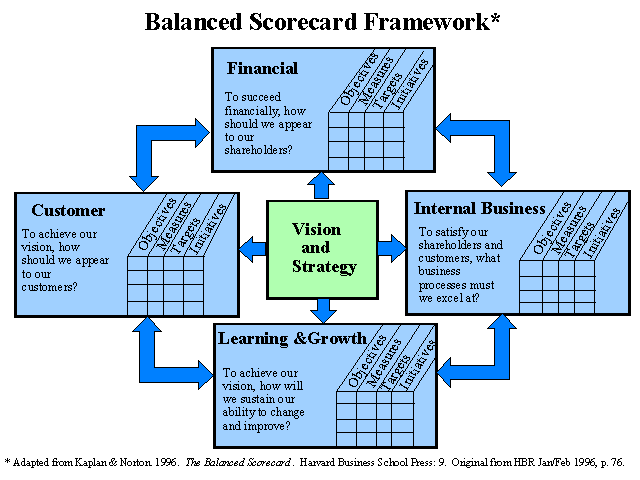The Balanced Scorecard
The Balance scorecard has been was introduced by Robert S. Kaplan and David P. Norton.
A performance metric used in strategic management to identify and improve various internal functions and their resulting external outcomes.
The balanced scorecard attempts to measure and provide feedback to organizations in order to assist in implementing strategies and objectives.
A Balanced Scorecard defines what management means by “performance” and measures whether management is achieving desired results. The Balanced Scorecard translates Mission and Vision Statements into a comprehensive set of objectives and performance measures that can be quantified and appraised.
The Balanced Scorecard goes beyond standard financial measures to assess the performance and also include the following additional perspectives: the customer perspective, the internal process perspective, and the learning and growth perspective.
The balanced scorecard translates the organization’s strategy into four perspectives, with a balance between the following:
- between internal and external measures
- between objective measures and subjective measures
- between performance results and the drivers of future results

These measures typically include the following categories of performance Perspective:
- Financial perspective – includes measures such as operating income, return on capital employed, and economic value added. (revenues, earnings, return on capital, cash flow)
- Customer perspective – includes measures such as customer satisfaction, customer retention, and market share in target segments. (market share, customer satisfaction measures, customer loyalty)
- Business process perspective – includes measures such as cost, throughput, and quality. These are for business processes such as procurement, production, and order fulfillment. (productivity rates, quality measures, timeliness)
- Learning & growth perspective – includes measures such as employee satisfaction, employee retention, skill sets, etc. (morale, knowledge, turnover, use of best demonstrated practices)
These four realms are not simply a collection of independent perspectives. Rather, there is a logical connection between them – learning and growth lead to better business processes, which in turn lead to increased value to the customer, which finally leads to improved financial performance.
Objectives, Measures, Targets, and Initiatives
Each perspective of the Balanced Scorecard includes objectives, measures of those objectives, target values of those measures, and initiatives, defined as follows:
- Objectives – major objectives to be achieved, for example, profitable growth.
- Measures – the observable parameters that will be used to measure progress toward reaching the objective. For example, the objective of profitable growth might be measured by growth in net margin.
- Targets – the specific target values for the measures, for example, +2% growth in net margin.
- Initiatives – action programs to be initiated in order to meet the objective.
These can be organized for each perspective in a table as shown below.
| Objectives | Measures | Targets | Initiatives | |
| Financial | ||||
| Customer | ||||
| Process | ||||
| Learning |
Balanced Scorecard as a Strategic Management System
The Balanced Scorecard originally was conceived as an improved performance measurement system. However, it soon became evident that it could be used as a management system to implement strategy at all levels of the organization by facilitating the following functions:
- Clarifying strategy – the translation of strategic objectives into quantifiable measures clarifies the management team’s understanding of the strategy and helps to develop a coherent consensus.
- Communicating strategic objectives – the Balanced Scorecard can serve to translate high level objectives into operational objectives and communicate the strategy effectively throughout the organization.
- Planning, setting targets, and aligning strategic initiatives – ambitious but achievable targets are set for each perspective and initiatives are developed to align efforts to reach the targets.
- Strategic feedback and learning – executives receive feedback on whether the strategy implementation is proceeding according to plan and on whether the strategy itself is successful (“double-loop learning”).
These functions have made the Balanced Scorecard an effective management system for the implementation of strategy. The Balanced Scorecard has been applied successfully to private sector companies, non-profit organizations, and government agencies.
What Balanced Scorecards do:
- Articulate the business’s vision and strategy
- Identify the performance categories that best link the business’s vision and strategy to its results (e.g., financial performance, operations, innovation, employee performance)
- Establish objectives that support the business’s vision and strategy
- Develop effective measures and meaningful standards, establishing both short-term milestones and long-term targets
- Ensure companywide acceptance of the measures
- Create appropriate budgeting, tracking, communication, and reward systems
- Collect and analyze performance data and compare actual results with desired performance
- Take action to close unfavorable gaps
Companies use Balanced Scorecards to:
- Clarify or update a business’s strategy
- Link strategic objectives to long-term targets and annual budgets
- Track the key elements of the business strategy
- Incorporate strategic objectives into resource allocation processes
- Facilitate organizational change
- Compare performance of geographically diverse business units
- Increase companywide understanding of the corporate vision and strategy
